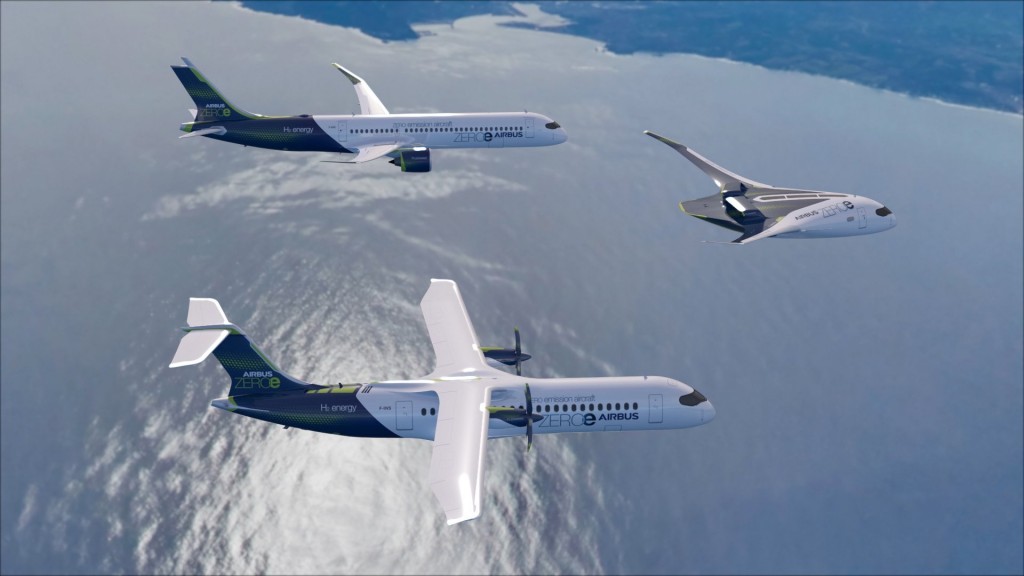Airbus turboprop design gaining favor as first hydrogen plane
A turboprop design is gaining momentum within Airbus SE as the solution to its challenge of developing a hydrogen jet by 2035, according to people familiar with the matter.
The propeller plane would carry around 100 passengers for about 1,000 nautical miles—roughly the distance between Rome and Dublin. It’s seen as the option most capable of meeting Airbus’ aggressive goal of introducing a zero-emission plane by the middle of the next decade, said the people, who asked not to be named because a formal decision is still several years away.
Airbus unveiled three design concepts including the turboprop last September, when it said it would focus on hydrogen technology to tackle the problem of growing carbon-dioxide emissions. No final decision has been made on which design to take forward, the people said, but the company is beginning to evaluate the potential of each proposal.

The other two designs are for a 200-seat blended wing, which Airbus has already said it’s unlikely to pursue first due to the challenges of certification, and a more-familiar-looking turbofan approach, which could fly more than 2,000 nautical miles—about two-thirds as far as the company’s mainstay A320 single-aisle jets.
A turboprop plane, while easier to develop, would address a niche market, making it less of a threat to conventional jets that go farther and faster. Should Airbus choose this approach, it might ease pressure on U.S. rival Boeing Co. to match its ambitions with hydrogen, and focus near-term competition between the two dominant planemakers on conventional aircraft.
“All of the studies are progressing well and we are not in a position to communicate further on which concept is the most promising,” an Airbus spokeswoman said in emailed comments. The company expects to make a final decision between 2024 and 2025, she added.
While Airbus moves ahead with its zero-emission plans, Boeing has said that hydrogen technology is still decades away, and is focused on developing planes that can use sustainable aviation fuels. Airbus has hinted that it too may make upgrades to its existing narrow-body models as an interim step before turning to hydrogen.
Climate Pressure
The turboprop has always been seen as the most do-able carbon-neutral option for Airbus to meet its goal of a 2035 debut, given the technology and range requirements, one of the people said. The technology that would be used in this model is already available and the biggest challenges would be bringing down the cost and scaling it up for the needs of a passenger aircraft, said another person.
The aviation industry is under tremendous pressure to curb carbon dioxide output. Long lead times for products and the technological difficulties involved means progress has been slower than in the automotive industry, for example, which is accelerating its shift toward electric cars.
Airbus is being pushed by its home governments in France and Germany, its biggest shareholders, to accelerate development of more sustainable aircraft. The two countries have committed some 2.5 billion euros ($3 billion) to cleaner propulsion.
While the Toulouse, France-based company may be able to speed the timeline, the hurdles remain significant. Commercialization will require creating a whole hydrogen infrastructure and bringing down the cost sufficiently to persuade airline customers to make the switch.
Hydrogen Timeline
The company has said previously that it plans to spend five years developing the concepts and doing demonstrator programs, before taking another two years to choose suppliers and manufacturing sites and beginning the program in around 2028. The final model would then come into service in 2035.
In December, Airbus said it was studying the potential to use hydrogen fuel cells in pods under the wings of the aircraft. The six self-contained pods, pictured with the image of a turboprop aircraft, would power electric motors driving the propeller. This would avoid the technical challenges of hydrogen combustion.
Speaking this week at the Pacific Northwest Aerospace Alliance’s Annual Conference, Airbus Americas Vice President for Research and Technology Amanda Simpson laid out the advantages of the pod system.
“Each pod is a fully configured system—it has the propeller, the motor, the fuel cell, all the power electronics, hydrogen tank, cooling system, all the auxiliary equipment and can be easily swapped for maintenance,” she said. “It’s another one we’re going to be looking at as we head into 2025 and make our decision as to which one we’re going to pursue.”
Similar Stories

ECS Group partners with CargoAi to digitalize manual email quotation processes with their CargoCoPilot API
View Article
Chapman Freeborn restructure to expand European cargo operations
View Article
United Airlines fourth quarter profit ahead of expectations
View Article
WorldACD Weekly Air Cargo Trends (week 2) - 2025
View Article
Cathay Pacific releases traffic figures for December 2024
View ArticleXeneta announces Board of Director changes, supporting the transformation of ocean and air freight markets
Xeneta, the global reference for ocean and air freight rate data and intelligence, has announced changes to its Board of Directors. Marie-Pierre Rogers has been appointed as the new Chair,…
View ArticleGet the most up-to-date trending news!
SubscribeIndustry updates and weekly newsletter direct to your inbox!





